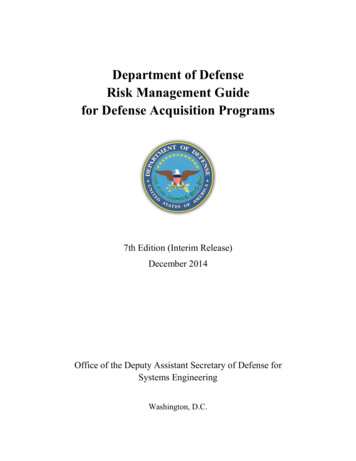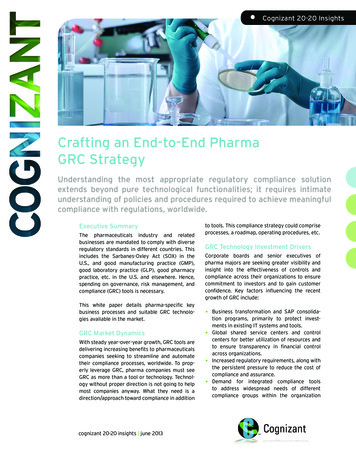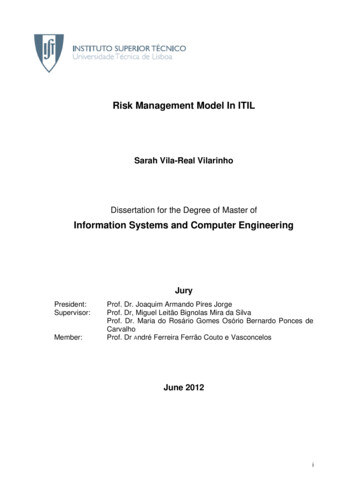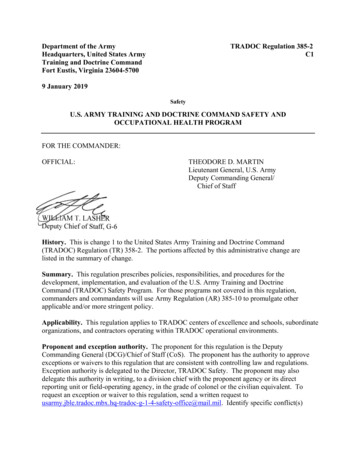
Transcription
Department of DefenseRisk Management Guidefor Defense Acquisition Programs7th Edition (Interim Release)December 2014Office of the Deputy Assistant Secretary of Defense forSystems EngineeringWashington, D.C.
Department of Defense Risk Management Guide for Defense Acquisition Programs, 7th Edition(Interim Release)Citation:Department of Defense Risk Management Guide for Defense Acquisition Programs, 7th ed. 2014.(Interim Release). Washington, D.C.: Office of the Deputy Assistant Secretary of Defense for SystemsEngineering.Deputy Assistant Secretary of DefenseSystems Engineering3030 Defense Pentagon3C167Washington, DC 20301-3030Email: osd.atl.asd-re.se@mail.milWebsite: www.acq.osd.mil/seDistribution Statement A: Approved for public release.
ContentsPREFACE . 112INTRODUCTION. 31.1Purpose . 31.2Scope . 41.3Risk Management Overview . 4ESTABLISHING AN EFFECTIVE RISK MANAGEMENT APPROACH . 62.1Risk Management Planning. 62.2Aligning Government and Contractor Risk Management . 72.3Risk Management Plan . 72.4Selecting a Risk Management Tool . 102.5Risk Management Roles and Responsibilities. 102.5.12.5.22.5.32.5.43Executive Level. 13Management Level . 13Working Level . 15Government and Contractor Relationship . 16RISK MANAGEMENT PROCESS . 193.1Risk Identification . 193.2Risk Analysis . 243.2.1 Likelihood . 253.2.2 Consequence . 263.2.3 Risk Reporting Matrix. 293.2.4 Risk Register . 323.3Risk Mitigation . 333.3.1 Risk Acceptance . 353.3.2 Risk Avoidance . 353.3.3 Risk Transfer . 363.3.4 Risk Control . 363.3.5 Risk Burn-Down . 363.4Risk Monitoring. 384INTEGRATING RISK MANAGEMENT WITH OTHER PROGRAM MANAGEMENT TOOLS . 414.1Work Breakdown Structure . 414.2Integrated Master Plans and Integrated Master Schedules . 424.2.1 IMS Health Assessment . 434.2.2 Schedule Risk Assessment . 454.2.3 Cost Risk Assessment Technique . 464.3Earned Value Management . 475ISSUE MANAGEMENT PROCESS. 48DoD Risk Management Guide for Defense Acquisition Programs, 7th Edition (Interim Release)iii
Contents6OPPORTUNITY MANAGEMENT PROCESS. 517MANAGEMENT OF CROSS-PROGRAM RISKS . 56APPENDIX A. RISK MANAGEMENT CONSIDERATIONS DURING ACQUISITION LIFE CYCLE PHASES . 611.Pre-Materiel Development Decision . 622.Materiel Solution Analysis (MSA) Phase . 633.Technology Maturation and Risk Reduction (TMRR) Phase. 654.Engineering and Manufacturing Development (EMD) Phase . 685.Production and Deployment (P&D) Phase . 716.Operations and Support (O&S) Phase . 727.Systemic Areas of Risk Found in DoD Acquisition Programs. 73APPENDIX B. COMMON RISKS AND MITIGATION ACTIVITIES. 741.Risk: Technical (Requirements) . 742.Risk: Technical (Technology) . 763.Risk: Technical (Integration, Testing, Manufacturing) . 774.Risk: Programmatic (Schedule) . 795.Risk: Programmatic (Communication). 806.Risk: Business (Dependencies) . 817.Risk: Business (Resources) . 83APPENDIX C. SAMPLE TEMPLATES: REPORTING MATRICES FOR RISKS, ISSUES AND OPPORTUNITIES . 841.Sample Risk Register . 842.Risk Cube . 853.Alternate to the Risk Reporting Matrix . 864.Issue Tracking Sheet. 875.Sample Opportunity Tracking Matrix . 88APPENDIX D: BETTER BUYING POWER INITIATIVES AND THE RISK MANAGEMENT GUIDE . 89ACRONYMS . 90REFERENCES . 92DoD Risk Management Guide for Defense Acquisition Programs, 7th Edition (Interim Release)iv
ContentsFIGURESFigure 1-1. Overview . 3Figure 1-2. Risk Management Process . 5Figure 2-1. Risk, Issue, and Opportunity Relationship . 6Figure 2-2. Sample Risk Management–Related Battle Rhythm . 11Figure 2-3. Roles and Responsibilities Tiering. 12Figure 3-1. Risk Management Process . 19Figure 3-2. Risk Identification . 22Figure 3-3. Risk Taxonomy . 23Figure 3-4. Risk Analysis . 25Figure 3-5. Risk Reporting Matrix. 30Figure 3-6. Prioritized Risk Matrix . 31Figure 3-7. Alternative Risk Reporting Matrix. 32Figure 3-8. Risk Register . 33Figure 3-9. Risk Mitigation. 33Figure 3-10. Sample Program Tier 1 Risk Reporting Matrix . 34Figure 3-11. Risk Burn-Down . 37Figure 3-12. Risk Monitoring . 39Figure 3-13. Risk Monitoring Matrix . 40Figure 4-1. Example of WBS Levels . 41Figure 4-2. Government and Contractor WBS Relationship . 42Figure 4-3. IMP/IMS Creation and Implementation . 42Figure 4-4. Sample Schedule Health Characteristics Assessment . 44Figure 4-5. Schedule Risk Assessments . 46Figure 5-1. Issue Management Process. 48Figure 5-2. Issue Reporting Matrix . 49Figure 5-3. Issue Tracking Matrix . 50Figure 6-1. Opportunities Help Deliver Should Cost Objectives . 51Figure 6-2. Opportunity Management Process . 52Figure 6-3. Opportunity Reporting Matrix . 53Figure 6-4. Sample Opportunity Tracking Matrix . 54DoD Risk Management Guide for Defense Acquisition Programs, 7th Edition (Interim Release)v
ContentsFigure 7-1. Notional Synchronization from the SEP Outline . 57Figure 7-2. Tracking Interdependency Risks . 59Figure A-1. Acquisition Life Cycle . 61Figure A-2. Materiel Solution Analysis Phase Risk Touch Points . 64Figure A-3. Technology Maturation and Risk Reduction Phase Touch Points . 66Figure A-4. Engineering and Manufacturing Development Phase Risk Touch Points . 69Figure A-5. Production and Deployment Phase Risk Touch Points . 71TABLESTable 3-1. Levels of Likelihood Criteria . 25Table 3-2. Levels and Types of Consequence Criteria . 27Table 7-1. Notional Table of Required MOAs from the Acquisition Strategy Outline . 57DoD Risk Management Guide for Defense Acquisition Programs, 7th Edition (Interim Release)vi
PrefaceIn his September 24, 2013, white paper, “Better Buying Power 3.0,” the Department of Defense(DoD) Under Secretary of Defense for Acquisition, Technology, and Logistics (USD(AT&L))emphasized his priority to improve leaders’ ability to understand and mitigate technical risk. Hestated, “Most of product development revolves around understanding and managing risk. Riskmanagement is an endeavor that begins with requirements formulation and assessment, includes theplanning and conducting a risk reduction phase if needed, and strongly influences the structure of thedevelopment and test program. All this is necessary to minimize the likelihood of program disruptionand to maximize the probability of fielding the desired product within reasonable time and cost.Effective risk management is proactive; it goes well beyond merely identifying and tracking risk.”This revised edition of the Department of Defense Risk Management Guide for Defense AcquisitionPrograms reflects revisions to emphasize risk management as a proactive tool to assist programs tobetter understand and mitigate risk throughout the acquisition lifecycle.This guide is one of several policy and guidance documents the Department is updating to addressthe USD(AT&L) Better Buying Power initiatives. The documents contain a common thread inemphasizing risk. Although a Risk Management Plan (RMP) is not mandatory, Program Managers(PM) are responsible for managing risk in accordance with the mandatory requirements contained inthe DoD Instruction (DoDI) 5000.02, “Operation of the Defense Acquisition System,” and arerequired to outline their risk management strategy in accordance with the Systems Engineering Plan(SEP) Outline (2011). DoDI 5000.02 requires PMs to identify top program risks and associated riskmitigation plans in the program acquisition strategy and to present that status at all relevant decisionpoints and milestones. Acquisition professionals may debate the best approach for managing risk,but they agree that effective qualitative and quantitative risk, issue, and opportunity management arecritical to a program’s success.This guide asserts that risk management should be forward-looking, structured, continuous, andinformative. The risk, issue, and opportunity management approach presented should be tailored tothe scope and complexity of each program’s individual needs.This guide is organized as follows:Chapter 1: Introduces the scope and changes in this revised edition of the DoD risk managementguide.Chapter 2: Discusses how to document the program’s risk management approach in the SEP, theSystems Engineering Management Plan (SEMP), the Acquisition Strategy, and the Risk ManagementPlan (RMP). Specifically, it discusses the organization and techniques for establishing an effectiveand systemic risk management approach before implementing a risk management process. Riskplanning is the process to develop and document the approach that lays out the methods andresponsibilities for executing risk management to include selecting the appropriate risk managementtools.DoD Risk Management Guide for Defense Acquisition Programs, 7th Edition (Interim Release)1
PrefaceChapter 3: Provides step-by-step guidance for developing a risk management process. It discussesthe four steps in the risk management process: identification, analysis, mitigation, and monitoring ofrisks.Chapter 4: Discusses proactive risk management through integrating with other programmanagement tools such as the Work Breakdown Structure (WBS), Integrated Master Schedule(IMS), Integrated Master Plan (IMP); and techniques such as Schedule Risk Assessments (SRA) andCost Risk Assessment Techniques.Chapter 5: Seeks to define the issue management process as a distinct and important managementprocess. An issue is an event or situation with negative consequences that has already occurred.Because issues have negative impacts on the program, they are often inappropriately managed asrisks.Chapter 6: Discusses the application of opportunity management including the similarities anddifferences to risk management. The opportunity management process is examined forundertaking potential enhancements to a program so the PM and functional leads can identify andimplement initiatives to yield improvements in the program’s cost, schedule, and/or performancebaseline. Opportunity management enables achieving “should” versus “will” costs discussed inBetter Buying Power 2.0 (USD(AT&L) 2012).Chapter 7: Highlights considerations to manage risks related to internal and external interfaces withinterdependent programs. It discusses the different priorities of interdependent programs andtechniques to manage and control cross-program risks.Most sections contain a text box with expectations that warrant “foot-stomping,” or emphasizing, toimprove the planning and execution of risk management processes and techniques.DoD Risk Management Guide for Defense Acquisition Programs, 7th Edition (Interim Release)2
1 INTRODUCTION1.1 PurposeThis guide seeks to inform Department of Defense (DoD) stakeholders regarding the effective use ofthe DoD risk management process to pinpoint and avoid potential program risk. It promotes the DoDprocess to identify, analyze, mitigate, and monitor risks, issues, and opportunities. Proactivelyaddressing not only risks but also issues and opportunities can help programs achieve cost, schedule,and performance objectives at every stage of the life cycle.For the purposes of understanding this guide, the terms risk, issue, and opportunity are defined as:Risk: Risks are future uncertainties relating to achieving program technical performance goalswithin defined cost and schedule constraints. Defined by (1) the probability of an undesiredevent or condition and (2) the consequences, impact, or severity of the undesired event, were it tooccurIssue: Issues are current problems (realized risks) that should be addressed with action plans,resourced and resolvedOpportunity: Opportunities are events that may or may not occur that have the potential forimproving the program in terms of cost, schedule, and performance. PMs should use opportunitymanagement to identify, analyze, plan, implement, and track initiatives that can yieldimprovements in the program's cost, schedule, and/or performance baseline by reallocatingprogram resources. Defined by (1) a likelihood of the future event occurring and (2) a benefitassociated with the future event.Figure 1-1 displays the technical, programmatic, and business events that can lead to opportunities,risks, or issues that have cost, schedule, or performance consequences.Figure 1-1. OverviewThe DoD risk management process is fundamental to acquisition program success. The PM isresponsible for implementing effective risk management in accordance with DoDI 5000.02,Enclosures 2 and 3. This guide will assist DoD and contractor PM’s, Chief or Lead SystemsDoD Risk Management Guide for Defense Acquisition Programs, 7th Edition (Interim Release)3
1 IntroductionEngineers, program offices, Integrated Product Teams (IPT), working groups, and others involved inimplementing risk management starting with a program’s inception and continuing through disposal.PMs are encouraged to apply the fundamentals presented here to improve the management of theirprogram.This guide should be used in conjunction with related directives, public law (Title 10 and theWeapon Systems Acquisition Reform Act of 2009), DoDI 5000.02 (“Operation of the DefenseAcquisition System”), Defense Acquisition Guidebook (DAG) Chapter 4 (Systems Engineering),Military Department guidance, instructions, policy memoranda, and regulations issued to implementrisk management in DoD acquisition programs.1.2 ScopeThis guide provides a basic understanding of risk management concepts as well as methods ofimplementation, so programs can select the appropriate mitigation for their situation. The practice ofrisk management draws from many management disciplines, including but not limited to programmanagement, systems engineering, earned value management, production planning, qualityassurance, logistics, and requirements definition. The risk management approach and process shouldbe tailored to fit the regulatory, statutory, and program requirements depending on where a programis in the life cycle.DoD clearly distinguishes mandatory policy from recommended guidance. This document servessolely as guidance for risk management approaches for DoD acquisition programs. The managementconcepts presented encourage the use of risk-based management practices along with a detailedprocess for risk, issue, and opportunity management. This guide does not attempt to address therequirements to prevent and manage environment, safety, and occupational health (ESOH) hazards.The reader should refer to MIL-STD-882E, Standard Practice for System Safety, for guidanceregarding ESOH hazards.This revision emphasizes areas that have emerged during Office of the Secretary of Defense (OSD)program reviews as potential areas for improvement across the range of DoD programs: Quantitative risk management Integration of risk management with other program management tools Issue management Opportunity management Managing risks with external programs Risks and proactive control activities throughout the acquisition life cycle phase1.3 Risk Management OverviewRisk is the combination of (1) the probability of an undesired event or condition and (2) theconsequences, impact, or severity of the undesired event, were it to occur. The undesired event mayDoD Risk Management Guide for Defense Acquisition Programs, 7th Edition (Interim Release)4
1 Introductionbe programmatic or technical, and either internal or external to the program. Although a future eventmay include positive opportunities, risk is considered to be the potential for a negative future event.Risk management should be fully integrated with the systems engineering and program managementprocess and should be applied beginning with the Analysis of Alternatives (AoA). Properlyimplemented and resourced, risk management enhances program management effectiveness andequips PMs with the tools needed to reduce life cycle costs (LCC) and increase the program’slikelihood of success. Without effective risk management planning and implementation, the programoffice could find itself conducting high-stakes crisis management.Through the risk management process, a program assesses the likelihood or probability of a futureevent and evaluates the consequences or severity of the event should it occur. The program identifiesthe origin of the risks in order to mitigate them before they become issues. Successful riskmanagement requires early planning, resourcing, and aggressive implementation. Through riskmanagement, program teams identify risk events that could prevent the program from achievingobjectives. The program is able to make decisions with a full awareness of the likelihood andconsequence of the risks involved.The DoDI 5000.02 and Better Buying Power 2.0 both emphasize risk management. The objective isto provide a repeatable process throughout all acquisition phases. It is essential that programs define,implement, and document an appropriate risk management approach that is organized,comprehensive, and iterative by addressing the following questions:1. Risk Identification: What can go wrong?2. Risk Analysis: What is the likelihood and consequence of the risk?3. Risk Mitigation: Should the risk be accepted, avoided, transferred, or controlled?4. Risk Monitoring: How has the risk changed?Figure 1-2 illustrates the risk management process.Risk IdentificationWhat can go wrong?Risk MonitoringHow has the riskchanged?Communicationand FeedbackRisk AnalysisWhat is the likelihoodand consequence of therisk?Risk MitigationShould the risk beaccepted, avoided,transferred or controlled?Figure 1-2. Risk Management ProcessDoD Risk Management Guide for Defense Acquisition Programs, 7th Edition (Interim Release)5
2 ESTABLISHING AN EFFECTIVE RISK MANAGEMENT APPROACH2.1 Risk Management PlanningThe first step in developing a risk management process is planning, during which a program selectsthe best overall approach (organization, tools, methods) for that program. If program-relatedactivities begin in the Materiel Solution Analysis (MSA) phase, risk planning should begin with theAoA, during which stakeholders assess the technology maturity, integration, manufacturingfeasibility, and schedule risks associated with each proposed materiel solution.Effective risk management requires an efficient process for identifying risk early, analyzing the riskevent likelihood and consequence, mitigating risk, and monitoring risk status. Acquisition programsmay vary in complexity, from the simple procurement of existing systems to development of state-ofthe-art advanced technology systems; however, effective risk management approaches haveconsistent characteristics and follow common guidelines regardless of program size. Progressionthrough the risk management process should be similar among programs, but the level of detail andinsight will depend on the program phase. At any point of the risk management process, the risksshould be traceable to the technical requirements and overall program objectives.The PM should begin planning and establishing the risk management process as soon as practicalafter establishment of the program office. As illustrated in Figure 2-1, the risk management processis closely linked with a program’s cost, schedule, and performance metrics. The risk managementprocess should remain an integral part of the program management process rather than a separate,isolated activity and should be implemented throughout the program’s life. Issues and opportunitiesshould be an element of the PM process but are managed differently than ufacturingEtc.What can go mmunicationContract structureEstimatesEtc.What omerEtc.What can be quences: Cost, Schedule, and PerformanceFigure 2-1. Risk, Issue, and Opportunity RelationshipDoD Risk Management Guide for Defense Acquisition Programs, 7th Edition (Interim Release)6
2 Establishing an Effective Risk Management Approach2.2 Aligning Government and Contractor Risk ManagementThe Government program office, the prime contractor program office, and associated subcontractorsshould employ a consistent risk management process and establish a joint risk management database.Risk management is not a stand-alone program office task but should be integrated with otherprocesses, such as requirements development; design, integration, and test (systems engineering);planning and management of system suppor
Chapter 1: Introduces the scope and changes in this revised edition of the DoD risk management guide. Chapter 2 Discusses : how to document the program’s risk management approach in the SEP, the Systems Engineering Management Plan (SEMP), the










